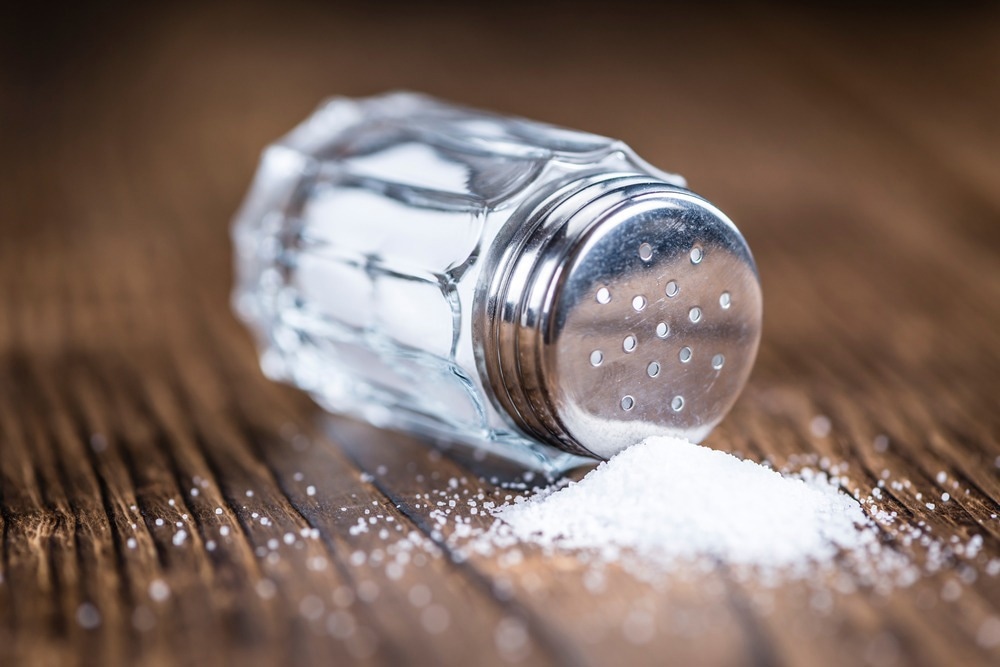Study uncovers link between salt-adding habits and type 2 diabetes

A recent study explored the possible interaction of added salt in food with the rate of new type 2 diabetes mellitus (T2DM) to understand the contribution of long-term sodium intake to diabetes incidence. The paper was published in Mayo Clinic Proceedings.

Background
Sodium is part of salt or sodium chloride. It is essential to maintaining the fluid-electrolyte balance of the body, facilitating the absorption of several nutrients, and keeping cell processes running. However, an excess of sodium in the diet is a risk factor for the development of hypertension.
Closely associated with hypertension is T2DM due to many common risk factors like a sedentary lifestyle, overweight or obesity, and poor diet quality. The absence of a reliable measure of dietary sodium has hampered the accurate estimation of an association between sodium intake and T2DM risk.
One Finnish study showed a J-shaped risk association, indicating that T2DM risk increased with very low as well as very high sodium intake levels. This study was based on one 24-hour urinary sodium excretion, which is unreliable in providing an estimate of average sodium consumption. Without such estimates, associations between sodium intake and disease incidences, as reported in previous studies, are inconsistent, as might be expected.
About the study
The current study relies on the reported fact that there is a strong and reliable link between the frequency of salt addition to food and free salt intake, as well as long-term sodium intake, at least with a Western diet. The authors have previously shown that the frequency of salt addition is correlated with 24-hour sodium excretion as well as the odds of premature death and CVD.
Thus, this characteristic could be a useful surrogate marker for long-term sodium intake. The present study employs this to identify associations with T2DM risk prospectively.
In addition, it looks at the potential role of body fat mass and inflammation in mediating such an association. Both are risk factors for T2DM, and both may possibly be induced by high sodium intake. The researchers examined the body mass index (BMI), waist-hip ratio (WHR), and C-reactive protein levels, the first two in relation to body mass and the last as an estimate of inflammation.
The study drew data from the UK Biobank, which collected data from March 2013 to October 2010. For the current research, the investigators included over 400,000 participants who had not been diagnosed with diabetes, chronic kidney disease (CKD), cancer, or cardiovascular disease (CVD) when the study began. In each case, data on whether and how often they added salt to food was also available.
The participants were followed up for a median of 12 years.
What did the study show?
The frequency of salt addition to food was correlated with higher 24-hour sodium excretion, ranging from 3.19 to 3.3, from the “never/rarely” to “always” groups, respectively.
During the study period, over 13,000 new diagnoses of T2DM were made. There was a small increase in T2DM incidence correlated with increasing frequency of salt addition to food.
Men were more likely to add salt more frequently, as were non-Whites, those at a lower socioeconomic level, smokers, and more sedentary people. Both the BMI and the CRP were also likely to be higher in the more-salt categories, who had, however, a lower risk of high cholesterol and hypertension. They were less likely to be on a diet to reduce hypertension.
Compared to those who rarely or never added salt, those who sometimes did so had ~10% increased odds of developing T2DM after adjusting for other potential confounding factors. The odds increased to ~20% and ~30% higher than the reference group among those who usually and always added salt.
Salt addition did not, interestingly, correlate with the baseline prevalence of hypertension or other variables when it came to impacting the incidence of T2DM.
Some factors that were probably responsible, at least in part, for the association of new T2DM and salt addition included a higher body mass, as shown by the body mass index (BMI), waist-hip ratio (WHR), and C-reactive protein (CRP) levels. The first two, which accounted for 34% and 40% of the association, respectively, drive the association because of the effect of increased body fat mass on the T2DM risk.
Despite their mediating effect, added salt intake still had an independent effect on T2DM risk. This remained significant even after compensating for the anti-hypertension diet, total energy intake, or glycated hemoglobin levels (which reflect long-term hyperglycemia).
With higher urinary 24-hour sodium, the T2DM risk increased from the fourth to the fifth quintile compared to the first quintile.
What are the implications?
“Our findings for the first time indicate that higher frequency of adding salt to foods, a surrogate marker for a person’s long-term salt taste preference and intake, is associated with a higher T2D risk.”
This association did not depend on socioeconomic status or lifestyle factors but was due in part to the sodium-dependent increase in body fat and inflammation. Other factors are also involved, accounting for the independent risk posed by increased salt intake.
These results are corroborated by cross-sectional research showing that patients with diabetes tend to add salt to food more often than non-diabetic individuals. Moreover, spot urinary sodium also reflects progressively increasing T2DM risk even though it denotes short-term sodium intake and is subject to various other diabetes-promoting regulatory factors such as the renin-angiotensin-aldosterone system, estrogens and vitamin D.
The study indicates the potential utility of interventions that target salt-adding behavior to prevent T2DM. Further research is required to confirm and establish these findings.
- Wang, X. et al. (2023). Dietary sodium intake and risk of incident type 2 diabetes. Mayo Clinic Proceedings. doi: https://doi.org/10.1016/j.mayocp.2023.02.029. https://www.mayoclinicproceedings.org/article/S0025-6196(23)00118-0/fulltext.
Posted in: Medical Science News | Medical Research News | Healthcare News
Tags: Aldosterone, Angiotensin, Body Mass Index, Cancer, Cardiovascular Disease, Cell, Cholesterol, Chronic, Chronic Kidney Disease, C-Reactive Protein, Diabetes, Diabetes Mellitus, Diet, Electrolyte, Food, Frequency, Glycated hemoglobin, Hemoglobin, High Cholesterol, Hyperglycemia, Inflammation, Kidney, Kidney Disease, Nutrients, Obesity, Protein, Renin, Research, Running, Type 2 Diabetes, UK Biobank, Vitamin D

Written by
Dr. Liji Thomas
Dr. Liji Thomas is an OB-GYN, who graduated from the Government Medical College, University of Calicut, Kerala, in 2001. Liji practiced as a full-time consultant in obstetrics/gynecology in a private hospital for a few years following her graduation. She has counseled hundreds of patients facing issues from pregnancy-related problems and infertility, and has been in charge of over 2,000 deliveries, striving always to achieve a normal delivery rather than operative.